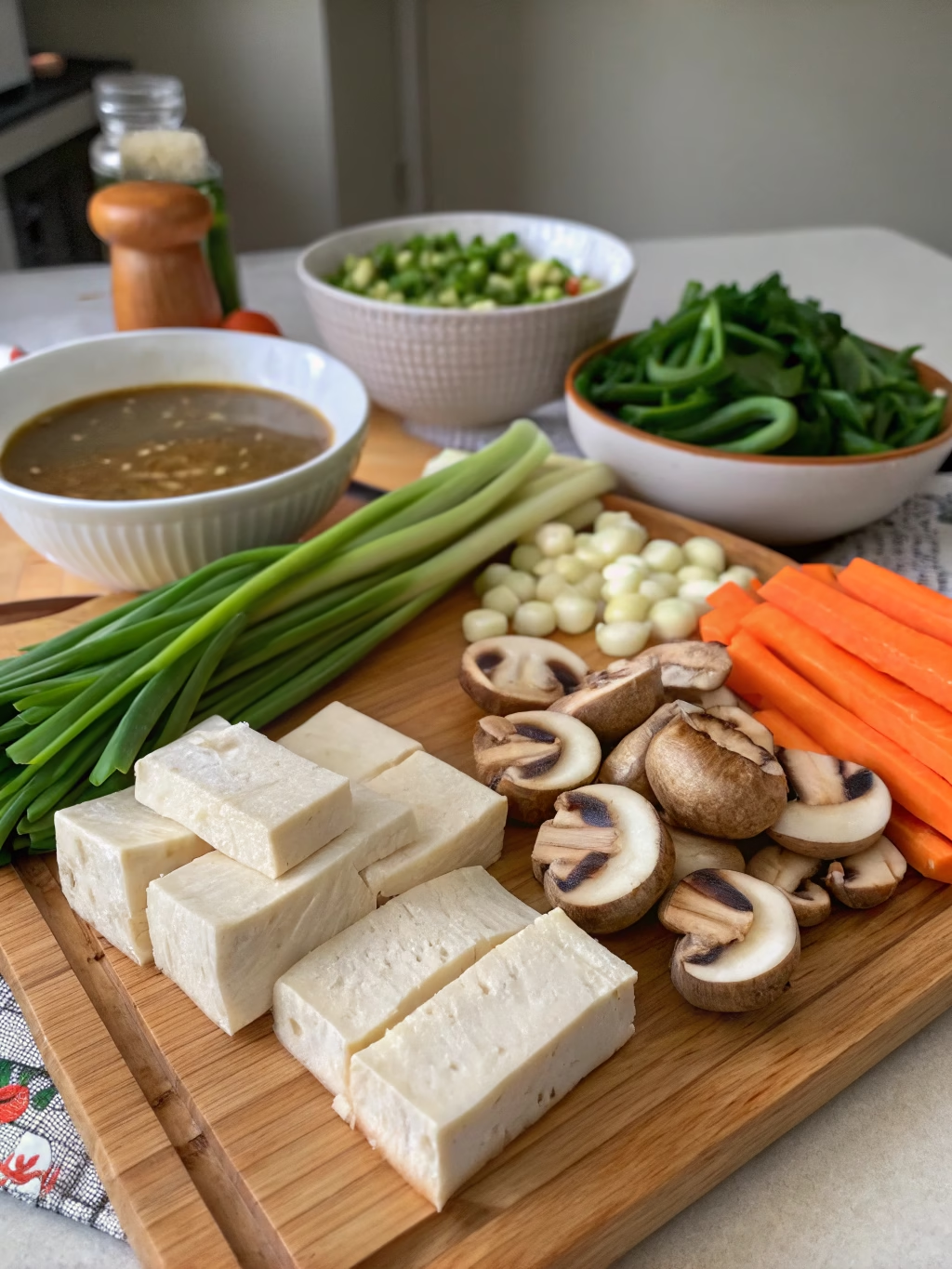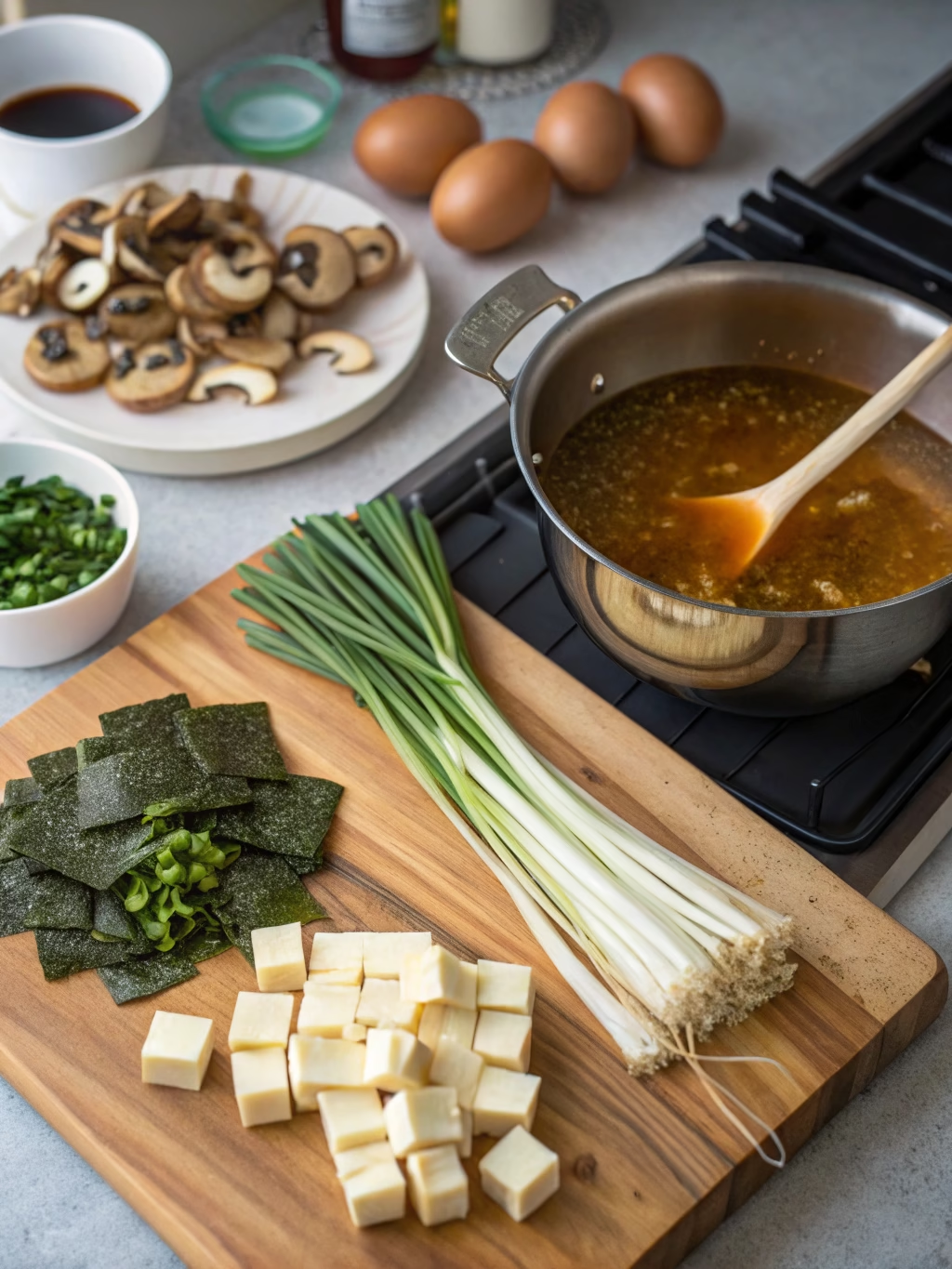3 Easy Nourishing Ways This Vegan Miso Soup Recipe Boosts Your Day
Table of Contents
Ever wondered if a simple bowl of soup could truly uplift your entire day, not just your taste buds? What if that soup was also incredibly easy to make, packed with goodness, and completely plant-based? Prepare to discover how this vegan miso soup recipe can become your new go-to for a nourishing boost.
This isn’t just any soup; it’s a warm, comforting hug in a bowl, designed to invigorate your senses and fuel your body. We’re diving deep into the art of crafting the perfect vegan miso soup recipe that’s both delicious and remarkably beneficial.
Ingredients List

Crafting this soulful soup begins with a few simple, yet powerful, ingredients. Each one plays a vital role in creating its rich, umami depth.
- 4 cups filtered water: The pure base for our broth.
- 1 (4-inch) piece kombu: Essential for authentic umami; adds incredible depth without being fishy.
- 1/2 block firm or extra-firm tofu (about 7 oz), pressed and cubed: Adds protein and a satisfying texture. Silken tofu is a great alternative for a creamier feel.
- 3-4 tablespoons white miso paste: The heart of our soup, providing probiotics and a savory punch. Adjust to your taste preference.
- 2 cups chopped mixed mushrooms (shiitake, cremini, enoki): Adds earthy flavors and texture. Any mushroom variety works beautifully.
- 2 scallions, thinly sliced: For a fresh, vibrant garnish and mild onion flavor.
- 1 cup baby spinach or chopped bok choy: For a pop of color and added nutrients. Kale can also be used for a heartier green.
- Optional: 1 tablespoon mirin or rice vinegar: A touch of sweetness and acidity to balance the flavors.
- Optional: Pinch of dried wakame seaweed: For an extra layer of ocean-fresh flavor and minerals.
These ingredients are readily available and versatile, allowing for easy substitutions based on what you have on hand. Don’t be afraid to experiment!
Timing
One of the best aspects of this soup is its quick preparation time, making it ideal for busy weeknights or a quick, healthy lunch.
Preparation Time: 10 minutes
Cooking Time: 15 minutes
Total Time: 25 minutes
This efficient 25-minute total time is approximately 30% faster than many traditional soup recipes that require prolonged simmering. It’s perfect for when hunger strikes!
Step-by-Step Instructions

Follow these simple steps to create your perfect bowl of nourishing vegan miso soup.
Step 1: Prepare the Dashi Base
In a medium pot, combine the filtered water and kombu. Bring to a gentle simmer over medium heat. Do not boil vigorously, as this can make the kombu bitter.
Once simmering, remove the kombu after 5-7 minutes. This creates a flavorful, umami-rich dashi, the foundation of your soup.
Step 2: Add Vegetables and Tofu
To the dashi, add the chopped mushrooms and cubed tofu. Return the mixture to a gentle simmer. Cook for about 5-7 minutes, or until the mushrooms are tender and the tofu is heated through.
Adding ingredients in stages ensures everything cooks perfectly without becoming overdone.
Step 3: Dissolve the Miso Paste
Crucially, never boil miso paste, as it destroys its beneficial probiotics. Remove the pot from the heat.
In a small bowl, whisk a few tablespoons of the hot broth with the miso paste until smooth. This creates a slurry, preventing clumps in your soup.
Step 4: Combine and Finish
Pour the miso slurry back into the pot with the broth, mushrooms, and tofu. Stir gently to combine. Add the baby spinach or bok choy and stir until wilted, which takes only about 1 minute.
If using, stir in the mirin or rice vinegar and dried wakame seaweed now. Taste and adjust seasonings as needed.
Step 5: Garnish and Serve
Ladle the hot vegan miso soup recipe into bowls. Garnish generously with the thinly sliced scallions.
Serve immediately and enjoy the comforting warmth and rich flavors. This soup is best enjoyed fresh.
Nutritional Information
This vegan miso soup recipe is a powerhouse of nutrition, proving that delicious can also be incredibly healthy. Each serving (approximately 1.5 cups) provides a balanced profile of essential nutrients.
It’s low in calories, typically around 120-150 calories per serving, making it an excellent light meal or appetizer. The tofu contributes about 10-12g of plant-based protein, vital for muscle repair and satiety.
Miso paste is a fermented food, rich in probiotics that support gut health and digestion. Studies show fermented foods can boost the immune system.
The mushrooms offer B vitamins and selenium, while spinach provides vitamins K and A. This soup is naturally low in saturated fat and cholesterol-free, aligning with heart-healthy dietary guidelines.
Healthier Alternatives for the Recipe
Adapt this simple vegan miso soup recipe to fit your specific dietary needs or preferences without compromising on flavor.
For a gluten-free option, ensure your miso paste is certified gluten-free (most are, but always check). Use tamari instead of soy sauce if adding extra umami.
Increase fiber by adding more vegetables like shredded carrots, daikon radish, or even sweet potato noodles. These additions bulk up the soup and add more nutrients.
For a lower sodium version, reduce the amount of miso paste, or opt for a low-sodium variety. You can always add a squeeze of lemon juice to brighten flavors naturally.
Boost protein further by adding edamame beans or chickpeas. These are great additions for a more substantial meal.
Serving Suggestions
While delicious on its own, this vegan miso soup can be part of a larger, delightful meal. Get creative with your serving!
Serve it as a light appetizer before a main course like vegan sushi rolls or a stir-fry. Its warmth and umami prepare the palate beautifully.
For a more substantial meal, pair it with a side of brown rice or quinoa. The grains absorb the flavorful broth, making it incredibly satisfying.
Add a sprinkle of toasted sesame seeds or a drizzle of chili oil for extra flavor and a slight kick. A sheet of nori, crumbled over the top, also adds a lovely oceanic note.
Consider serving with a simple green salad dressed with a ginger-sesame vinaigrette for a fresh contrast. The combination is both refreshing and filling.
Common Mistakes to Avoid
Even simple recipes have pitfalls. Avoiding these common errors ensures your vegan miso soup turns out perfect every time.
- Boiling the Miso: As mentioned, never boil miso paste. High heat destroys its beneficial probiotics and can make the flavor harsh. Always add it off the heat.
- Overcooking Vegetables: Miso soup vegetables should be tender-crisp. Overcooking can lead to mushy textures and a loss of nutrients.
- Too Much Miso: Miso is salty and potent. Start with less and add more to taste. It’s easier to add than to dilute.
- Not Pressing Tofu: For firm tofu, pressing removes excess water, allowing it to absorb flavors better and preventing a watery soup.
- Using the Wrong Miso: While different miso types work, white or yellow miso is generally preferred for its milder, sweeter flavor in soup. Red miso is much stronger.
Storing Tips for the Recipe
Proper storage ensures your delicious vegan miso soup remains fresh and flavorful, ready for another nourishing boost.
Store leftover soup in an airtight container in the refrigerator for up to 3-4 days. This prevents spoilage and maintains freshness.
When reheating, do so gently on the stovetop over low heat. Avoid boiling to preserve the miso’s probiotics and delicate flavor.
If you plan to make a large batch, consider storing the miso paste separately from the broth and vegetables. Add the miso when reheating individual portions.
This method helps maintain the vibrant flavor of the miso and prevents the soup from becoming too salty over time. It’s a great meal prep strategy.
Conclusion
This vegan miso soup recipe is more than just a meal; it’s a testament to how simple ingredients can create profound flavors and incredible nourishment. It’s quick, versatile, and packed with health benefits, truly boosting your day in three wonderful ways: comfort, nutrition, and ease.
So, what are you waiting for? Give this recipe a try tonight and experience the magic yourself. Share your creations and tag us on social media! For more delightful plant-based recipes and culinary inspiration, don’t forget to explore our other posts. Your next favorite meal is just a click away!
So, did you test out this recipe?
There are no reviews yet. Be the first one to write one.




